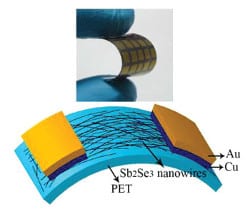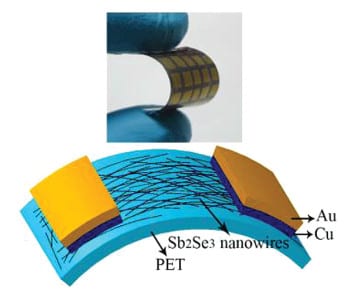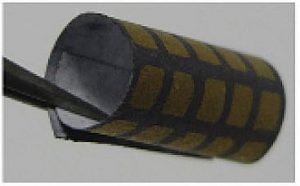
Photograph (top) and schematic illustration of a flexile atimony selenide (Sb2Se3) photodetector, fabricated on a polyethylene terephthalate (PET) substrate.
Ultrathin nanowires with diameters <20 nm have been controllably synthesized and put to use in flexible photodetectors by researchers at the University of Science and Technology of China.
High aspect ratio nanowires can achieve high performance thanks to low-scattering carrier transport paths and discrete electron and hole energy states, which arise from the spatial confinement. Moreover, such nanowires are mechanically flexible, making them ideal for use in flexile electronic devices.
In their recent Communication, Q. Yang and co-workers report the synthesis of ultrathin (diameters <20 nm) antimony selenide (Sb2Se3) nanowires using an organometallic synthetic route. By tuning the reaction temperature of triphentlantimony with dibenzyldiselenide in ethanol, and using oleyamine and polyvinylpyrrolidone as surfactants, the nanowire morphology can be tuned.
As a narrow band semi-conductor with good chemical stability, Sb2Se3 is an excellent candidate for visible–near-infrared photodetectors. Here, the researchers present promising flexile photodetectors with fast response and recovery times using their Sb2Se3 nanowires. They compare the characteristics of photodetectors using both a polyethylene terephthalate substrate, and a regular printing paper substrate. The devices show high flexibility and mechanical stability, with photocurrents that remain practically unchanged with variation in the device bending state.
The significant potential of ultrathin Sb2Se3 nanowires for functional, low-cost, flexible and portable electronic and optoelectronic devices is highlighted by the thorough characterization carried out by the authors.
Advanced Science is a new journal from the team behind Advanced Materials, Advanced Functional Materials, and Small. The journal is fully Open Access and is free to read now at www.advancedscience.com.


















